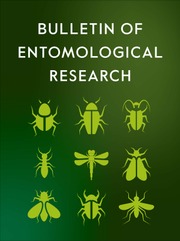Article contents
Observations on Rate of Growth, Coloration, and the abnormal Six-instar Life-cycle in Locusta migratoria migratorioides, R. &. F.
Published online by Cambridge University Press: 10 July 2009
Extract
1. All material was reared under constant conditions of temperature, light intensity and relative humidity. Two relative humidities were used—very wet and very dry. In some cases various coloured backgrounds were used. All material was solitaria, and was kept isolated.
2. Average weights were calculated from weighings made at all periods within the stadia, and thus represent the weights at the mid-points of the stadia.
3. The figures could not be fitted to the theory of a progression factor of 2.
4. Females are on the average 50 per cent, heavier than males even in the third instar; the sexes can probably be distinguished in this way much earlier.
5. The first three stadia are of about the same length; the fourth is longer, the fifth much longer.
6. The percentage rate of growth between the mid-points of successive stadia is of the same order for all pairs, though somewhat lower for the first and last pairs.
7. Hoppers kept in a very dry atmosphere are much lighter than those kept wet —proportionally more so in the later than in the earlier instars; on the other hand each stadium is lengthened—proportionally more so in the earlier than in the later stadia; the percentage rate of growth is just half that of hoppers kept wet.
8. The findings of Faure in regard to the causes of differences in coloration were fully confirmed.
9. The occurrence of a sixth instar in the females is due to an inherited factor.
10. This “ extra ” instar may represent an extra morphological third instar or an extra morphological fourth instar.
- Type
- Original Articles
- Information
- Copyright
- Copyright © Cambridge University Press 1936
References
- 15
- Cited by




